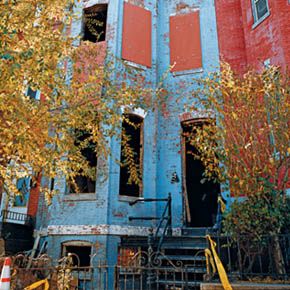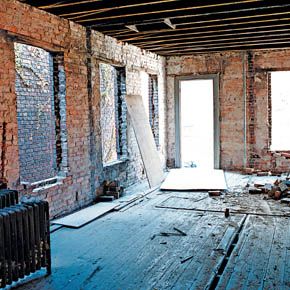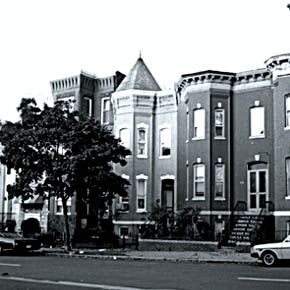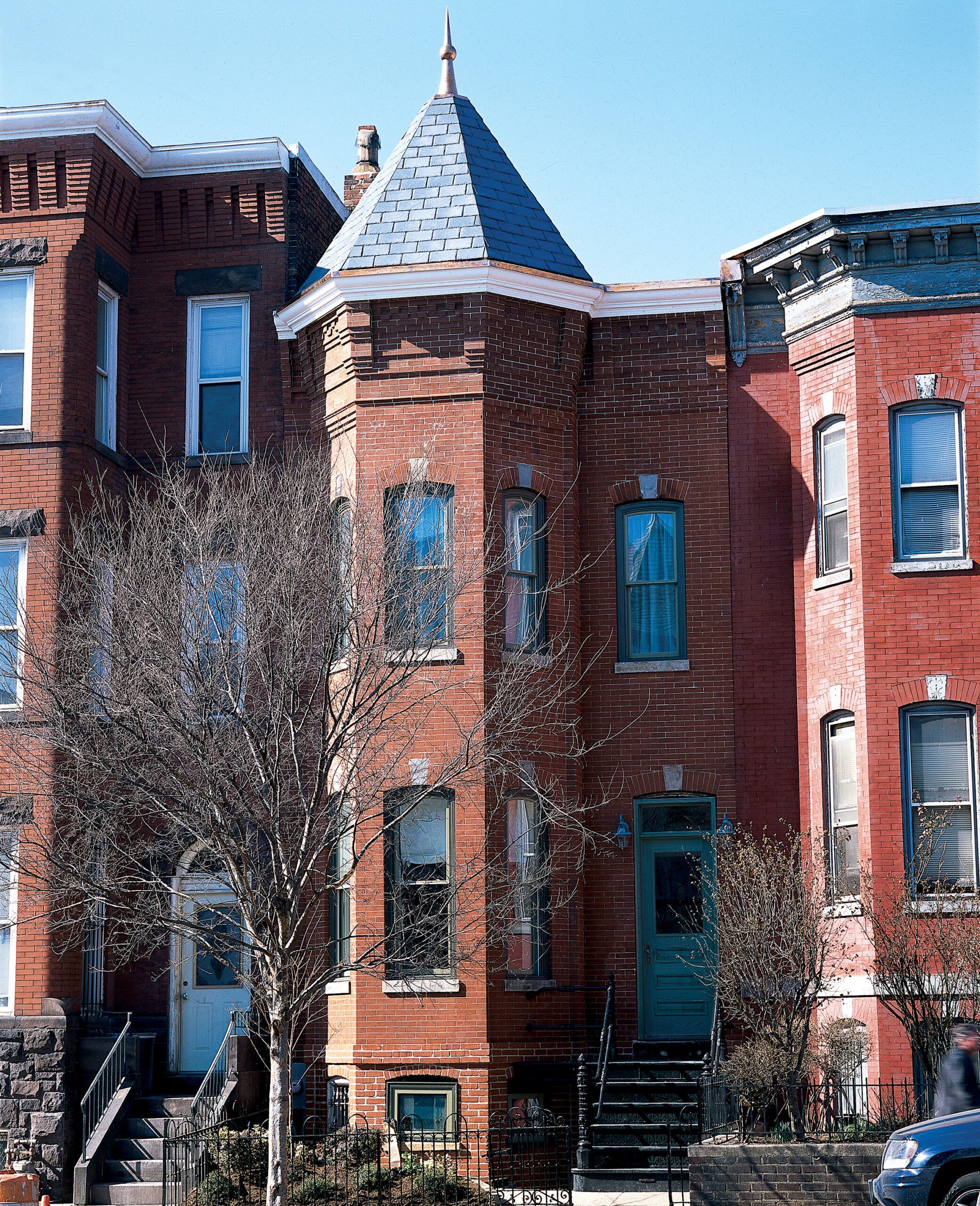
It’s not that the boarded-up row house in Washington, D.C., was totally empty when Mi Casa Inc. acquired it from the city. It certainly had a lot inside: crumbled plaster, charred ceiling joists, garbage, animal bones, empty bottles, needles—all the detritus that went with its status as an abandoned inner-city building. It’s just that it didn’t have much of anything that made it look like the 1879 Italianate it once was.
Mi Casa, a nonprofit developer, intended to renovate the house, located in Shaw, a reviving neighborhood not far from the White House, and then sell it at cost to a low-or middle-income family. But the building was a mere shell by the time the team from This Old House television showed up to document the transformation. There wasn’t one window left. The original living room mantel had been stolen. A fire had left the brick at the cornice ruined and the oak flooring water-damaged. And all the window and door casings were gone, save two in the kitchen—and even those were nearly thrown away.
With nothing left to give the house character, the renovation team, headed by local contractor Mahyar Mahvi, had to be creative.
In the few places they could, they painstakingly copied remnants of detail. Where there were no such clues, they compromised on designs that were close but not exactly the same. And in areas where durability and efficiency were paramount, they installed new materials that looked original but were better made.
Whether it’s in a whole house or just one room, every renovator encounters these issues. Here’s how the team brought detail—and life—back to their house, using methods that will work on your home as well.

Replicate
Copy lost details from scraps, photos, and other vestiges of the past
Sometimes it’s the simple clues that yield the greatest results. A small piece of trim, a family photograph taken in front of a house, a neighbor with a good memory—all can offer information about how architectural details once looked.
Take, for instance, a 1983 picture of the house from the city’s Historic Preservation Office. It shows a conical turret, and stepped corbels at the cornice—elements that disappeared when the city did emergency repairs after a fire in the 1990s. Homeowners can often find such old photos at local historical societies and tax departments, which take them for record-keeping. Previous owners, or even neighbors, may also have pictures that show the house in the background.
Danny Palousek, a preservation mason hired to restore the brickwork, blew up the photo to study the cornice’s pattern. He and his crew dismantled nearly six vertical feet of wall and rebuilt the original profile. (They replaced broken pieces with a matching brick found on a salvaged building in, of all places, Kansas.) After weeks of work—and a new turret from the roofers—the restored section of the facade blends seamlessly with the original remaining parts.
For David Baldwin and the rest of the team from American Cedar and Millwork (ACM), a woodworking shop in Millersville, Maryland, there wasn’t any worry about blending the moldings they created with what remained. By the time they showed up, even the two window and door casings left in the house had been demolished. All they could find was one paint-encrusted piece a couple of feet long. “We literally pulled it out of the Dumpster,” says Baldwin.
Molding in profiles from 125 years ago isn’t always easy to find, even at a well-stocked shop like ACM. But thankfully they’re easy to copy, and the short salvaged piece was all the shop needed to make a duplicate. Many mills will reproduce a molding profile, from a scrap or even from a drawing, by honing new cutting blades to match. These “knives” come at a minimum cost (around $250), but once they’re made, any shop can use them to cut the profile.
After stripping the paint off the scrap, the experts traced its outline onto thin metal that they shaped on a grinder. They used this template to cut two steel knives, then put the knives into the drum of a molding machine that shapes plain lengths of wood as they’re fed past the cutters. The mill ran 1,000 feet of the trim—enough for all the doors and windows. But without remnants of any other trim, they used existing stock for rosettes, chair rail, baseboard, and crown, choosing profiles that fit the house’s style and complement the new casings.

Approximate
Find a close match when there’s
no template or touchstone
Exact copies are great, but in situations where details are gone forever, period-appropriate substitutions, like the chair rail and other moldings, are more common. The house’s mantel is a perfect example.
Everyone who worked on the renovation before TOH became involved—from Elin Zurbrigg, the project director, to contractor Mahyar Mahvi—remembered the carved beauty that stood in the living room. No one, unfortunately, had taken a picture of it before thieves spirited it away—probably to sell to a salvage yard, where handcrafted treasures are in demand. So there was no consensus on what it looked like, and even if there were, there would be no guarantee that a match could be found. But when a detail is unique, sometimes a close approximation is a fair compromise.
A salvage yard is a great place to go looking for such substitutes, so TOH headed to The Back Door Warehouse, a D.C. yard overflowing with rescued house parts. There they found a carved-wood mantel that was the right size and period-appropriate. A dunk in the stripping tank and a few coats of wax, and the piece fit in nicely.
But salvage isn’t just for the solo detail. Master ironworker Fred Mashack, who restored the steel and cast-iron front stoop, collects metal parts in his riverfront shop in case he ever needs one for a restoration project. Good thing, because he had an acorn finial just like the one missing from one of the stoop’s newels.
Craftsmen like Mashack know how to take a tired piece like the staircase and make it look new again without compromising the design. He had to have the rickety newels stripped, repair the wobbly railing, and replace modern diamond-plate steps with new treads and risers.
Homeowners looking to replace iron elements—fences, gates, rails—can find a lot of old patterns still being cast by manufacturers. Mashack ordered the treads from a Pennsylvania-based fabricator that specializes in period ironwork. But he shaped the risers himself, using a modern plasma cutter to create an intricate design that wouldn’t look out of place among the neighborhood’s cast-iron originals. After making five risers from slabs of black steel, he assembled the stair in his shop, then dismantled it to install it on the front of the house, creating a perfect welcome mat for visitors to the refurbished home.

Buy New
Choose materials and fixtures that mimic the originals but perform better
Everyone likes to be able to save original features, like floors and windows. But when they’re too far gone, as the rotting floorboards in the D.C. project house were—or just gone altogether, as the windows were—it’s better to start from scratch.
Luckily, window and floor manufacturers will still make their products in styles similar to those that were popular 125 years ago. For the D.C. project house, which is a classic urban Italianate, that means arched one-over-one windows and strip oak flooring. But these days, they don’t make them like they used to. They make them even better.
The dual-paned windows from Eagle are much more efficient than originals with single panes would be, keeping air-conditioning in during summer and cold gusts out during winter. They also block ultraviolet rays and tilt in for cleaning—modern features on old-style fixtures.
The flooring, prefinished oak from Durawood, is solid wood—as it would have been in the 19th century. But unlike the unfinished oak the original builders would have used, which has to be sanded and coated with three layers of finish, this stuff is ready to walk on as soon as it’s installed and comes with a 25-year warranty.
Even the linoleum, from Forbo, that covers the kitchen floor has a modern twist: cork backing for cushioning and a snap-together assembly that allowed installers to finish the kitchen in mere hours. Yet another product that recalls the beauty of the past but brings the convenience of the present to the project.

Where to find it
Homeowner:
Mi Casa Inc.
Washington, DC
202-722-7423
General Contractor:
Venus Construction & Remodeling
Washington, DC
202-777-4000
Architect:
Genell V. Anderson,
AIA, The AMAR Group
Washington, DC
202-829-2577
Roofing Contractor:
Wagner Roofing
Hyattsville, MD
301-927-9030
Preservation Mason
Danny Palousek
Falls Church, VA
703-992-7781
Iron Restoration
Chem Strip
Upper Marlboro, MD
301-420-9112
Salvaged Mantel:
The Brass Knob Warehouse,
Washington, DC
202-265-0587
Kitchen Linoleum Flooring:
Marmoleum Click-in Virgin Blue and Arabsesque, Forbo Flooring
866-627-6653
Linoluem Distributor:
Nash Floor Company
Washington, DC
202-488-8440
Hardwood Flooring:
2 1/4-inch prefinished oak,
PRGS2S Casa de Colour Select Gunstock, Lumber Liquidators
800-356-6746
Flooring Installer:
All Wood Flooring
Silver Spring, MD
240-506-4779
Casement, awning, and double-hung windows:
Eagle Windows and Doors Inc.
Dubuque, IA
800-324-5354
Flooring Installer:
All Wood Flooring
Silver Spring, MD
240-506-4779
Entry Door:
KML by Andersen Entraceways.
Andersen Windows
Bayport, MN
800-426-4261

